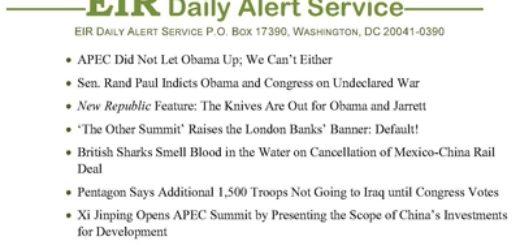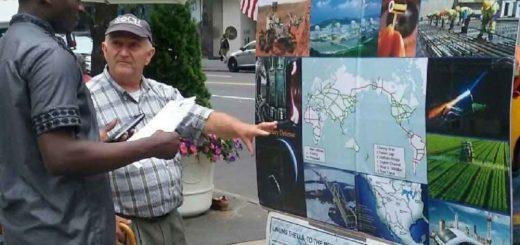EDITORIAL
‘When Ships To Sail the Void between the Stars Have Been Built, There Will Step Forth Men To Sail These Ships’
—Johannes Kepler
Aug. 25 (EIRNS)—Look to international operations and international factors as the most significant right now. Local reactions may be more limited, Lyndon LaRouche advised this week.
For example: Nations worldwide want to join, and will join with China in the long-term mission of mapping the Moon, around China’s breakthrough mission to the far side of the Moon in 2018. The Moon is the necessary stepping-stone to all of space. As Krafft Ehricke said: “If God wanted man to become a spacefaring species, he would have given man a Moon.” But how could anyone doubt that the United States must be fully involved in this process, by which mankind’s future, even generations ahead, is being created right now, by those alive today? Indeed this is the very purpose of life. Does Obama insist that we’re not going back to the Moon? “Been there; done that?” That shows what must be done with Obama, where Obama must go and why.
The history of mankind’s space program, from its start in Germany, through all its intricate developments of the 20th Century, and on to its future in the 21st Century and far beyond, is a global issue which must be treated globally, grounded especially in the insights of its leading author, Krafft Ehricke, who worked closely with Lyndon and Helga LaRouche, and fully shared their deep, total commitment.
A fuller understanding of this question in its full generality leads over into many other areas, which the poorly miseducated layman imagines he knows something about, but of which he knows nothing. Does he even know what a scientist is? Is a scientist someone who finds a better formula to represent so-called experimental results? No, not at all. And what is science?
People must have a broad understanding of mankind’s space program, its history and its future, in the kinds of broad terms in which Krafft Ehricke understood it. What are the issues which the back side of the Moon presents to us now, in terms of what the Solar System will signify for us later? We need to understand these in order to build up space policy into the future.
More generally, this aspect of history has to be located within the entire fabric of history. When people take on the entire compound fabric of history of the entire planet as their responsibility, they are forced to think that way, and they begin to produce that way.
Obama and what he represents must be removed,— by what means? We don’t know yet, but we have to dump him, or cause him to be dumped. If we don’t, you don’t know what may happen. He must be thrown out and clearly condemned, or else the possibility of saving civilization is in grave danger. He must be humiliated and eliminated from office. If we don’t, we’re in bad trouble.
The process must be moved ahead; we cannot let it control us.
NEW GLOBAL ECONOMIC ORDER
Many Countries Wanted China To Take the Lead in G20, Scholar Says
Aug. 25 (EIRNS)—In an interview with China Central Television (CCTV), Su Xiaohui, the Deputy Director of Strategic Studies at the China Institute of International Studies, said that other countries had been eager to have China host the G20 Summit at this critical time. “This is a very important summit for all the countries in the world,” Su said. “China is hosting this summit because it is what other countries wanted. It’s the other countries that wanted China to host this event. In recent years, there have been plenty of problems in the world economy, and all the countries in the world, including G20 members, are eager to find solutions. Other countries know China can be a leader in addressing the world’s economic problems. So they would like China to host this event, and provide the opportunity for other countries to deal with these problems.”
Su continued, “China has its own contribution to this platform. China has made some very successful achievements, like the AIIB, which is a very ambitious plan that has gained the support of many other countries. China is providing new ideas like innovation and green finance.” Speaking on CCTV, Prof. Liu Chunsheng from the Central University of Finance and Economics, pointed to three major tasks for the upcoming summit to tackle: 1) expanding trade and investment, 2) rebuilding a new world economic order, and 3) finding a new engine of growth through innovation and structural reform.
In the run-up to the event, which will focus on technological innovation, the Chinese Academy of Social Studies has issued a report on how each of the 20 nations can enhance its innovation strategies. “After the global financial crisis in 2008, most of the countries have started to place their hopes of economic recovery on technological innovation,” said Prof. Huang Maoxing from Fujian Normal University. “So what we are doing right now is to help the 20 economies find out the advantages and weakness of their technological innovation development, help them solve those problems, and consolidate their current achievements in the area. Besides, the G20 summit has been shifting its focus to investment, open trade and green finance. So we are also providing analysis on the development outlook in these areas.”
The Chinese Foreign Ministry confirmed that all 20 heads of state or government will be attending the summit, including Russia’s President Vladimir Putin, U.S. President Barack Obama, and British Prime Minister Theresa May, as well as the leaders of the UN, the World Bank, and the IMF.
The summit will also have a larger contingent of leaders from developing countries than at any other time. “The voices of developing countries will be fully heard at the G20 Summit,” said the spokesman for China’s Foreign Ministry, Lu Kang. “Developed and developing countries will make decisions on global economic affairs through consultation on an equal footing. It reflects a major change in the world economic landscape. It’s a response to the trend of the times, which is a historic progress,” Lu said.
Chairman of the Board of Eurasian Economic Commission Pays a Visit to Beijing
Aug. 25 (EIRNS)—Tigran Sarsyan, chairman of the board of the Eurasian Economic Commission (EEC), is now in Beijing to discuss the prospects of cooperation between China and the EEC. The EEC describes itself as the permanent regulatory of the Eurasian Economic Union (EAEU), comprised of Armenia, Belarus, Kazakhstan, Kyrgyzstan, and Russia. Sarsyan was previously the prime minister of Armenia and, in that post, had created close relations between Armenia and China. China is presently in negotiations with the EAEU over trade relations, an important element in establishing the collaboration between the EAEU and the Silk Road Economic Belt. Sarsyan said that while he knew negotiations were ongoing, he felt his visit would help in moving them “at a faster pace.” China’s Vice Premier Zhang Guoli said excessive changes are occurring in the world as the global recovery is happening very slowly and that “under those circumstances the Chinese leadership attaches huge significance to cooperation with EAEU.”
“China establishes friendly relations with all the members of the EAEU,” Zhang said.
Sarsyan replied, “I know that you personally supervise the Chinese initiatives and the new Silk Road development project, collaboration with which is one of the priority directions of EAEU’s development strategy.” Sarsyan said that the EAEU supports China’s approach of creating an economic architecture exempt from a political component.
Armenia also intends to participate in the Silk Road Economic Belt, with Armenian President Serzh Sargsyan having been in Beijing in March to sign an agreement on the creation of a North-South corridor through Armenia to the Caucasus.
India’s Prime Minister Modi and Russian President Putin To Meet on Sidelines of Major Summits
Aug. 25 (EIRNS)—In an article for the Indian daily The Asian Age, India’s former Ambassador to Kazakhstan, Sweden, and Latvia Ashok Sajjanhar highlights the closer cooperation developing between Russia and India. Sajjanhar said this cooperation is reflected in the recent India visit of Russian Deputy Prime Minister Dmitry Rogozin, who met with Prime Minister Narendra Modi, and the planned meetings between Modi and Russian President Vladimir Putin set to take place in early September on the sidelines of the G20 Summit, and again in Goa, India, in October when the BRICS Summit takes place.
Sajjanhar lists a number of collaborative projects between Russia and India in line with Modi’s “Make in India” initiative. In the nuclear energy area, beside the 1000-MW VVER nuclear reactors in Kudankulam, Sajjanhar wrote: “The Russian atomic power corporation Rosatom is interested in participating in the ‘Make in India’ program through assembly of fuel rods and control system components.” He also cites the joint production of 200 Russian light helicopters as part of the same program.
In addition, he notes “the development of the International North-South Transport Corridor, trial runs on which took place on Aug. 8, 2016, [and] construction and upgrading of Chabahar seaport [in Iran] to promote and improve connectivity with Central Asia, Russia and Afghanistan. India’s membership of Shanghai Cooperation Organization will provide several opportunities to promote security, stability and economic growth in Central Asia and the region.”
As Japan’s Abe Plans More Investment in Africa, China Also Discusses Higher-Quality Investment
Aug. 25 (EIRNS)—Japan’s Prime Minister Shinzo Abe will be attending the Aug. 27-28 Sixth Tokyo International Conference on African Development in Nairobi, and will meet with dozens of leaders from across Africa, including Kenyan President Uhuru Kenyatta and South Africa’s Jacob Zuma. The forum was first convened in 1993, but at Africa’s request, this is the first time that the forum will be held in Africa, Japan Today reports today.
According to a report in The East African today, “Tokyo will also be hoping to strike several trade deals with mineral-producing countries, as it relies on Africa’s mineral imports for the metals it needs in car manufacturing. Japan is one of the world’s biggest producers of automotive and electronic products.” The article cites Bloomberg that “the Japanese companies accounted for more than $7 billion investment in Africa compared with China’s $20 billion. Africa is becoming a lucrative investment destination for Asia’s leading economies, primarily China, India and Japan.”
Meanwhile, an op-ed in China’s Global Times, “China’s Africa Investment Shifts from Quantity to Quality,” by Yu Ning reports that dollar figures for China’s investment are waning in Africa. In Yu Ning’s view, this “is a sign that China is changing its approach, with more attention paid to quality rather than quantity. Chinese investment in natural resources in Africa is waning. Instead of eyeing mega-infrastructure projects for short-term gains as it did in the past, China now attaches more importance to expanding investment in the manufacturing industry…. The new approach offers preferential policies and support for more Chinese manufacturing enterprises to invest in Africa through the China-Africa Development Fund. These investment patterns better conform to the demands of industrialization in African countries.”
Great Potential Offered by International North-South Corridor Featured
Aug. 25 (EIRNS)—An article published by Sputnik news service highlights the broad international potentials opened by the decision taken at the Aug. 8 trilateral summit of Azerbaijan, Iran, and Russia to boost development of the North-South International Transport Corridor (N-SITC). That route will transfer seaborne cargo from Asian countries to the Iranian coast, and from there to Europe through Iran, Azerbaijan, and Russia by rail.
Although Sputnik headlines the N-SITC as replacing the Suez Canal, what it actually reports is its needed complementary role. “According to some estimates, currently about 10% of world seaborne trade passes through the Suez Canal. However, with the sanctions on Iran lifted, this figure may increase dramatically, threatening to turn the Canal into a ‘bottleneck’ for global trade. In light of this the new North-South corridor could bear the Canal’s growing burden,” Sputnik wrote.
Despite still lacking about 172 km of railroad track between Azerbaijan and Iran, the corridor “transported 7.3 million tons of cargo in 2015, marking a 4% increase in comparison with 2014,” Sputnik reported, adding “that besides Russia, Iran, India and Azerbaijan, the North-South Corridor project is expected to include Armenia, Belarus, Ukraine, Greece, Bulgaria, Georgia, Kyrgyzstan, Tajikistan, Kazakhstan, Pakistan, Iraq, Oman, Syria and Turkey.”
In conclusion, the article points out that because of “Turkey’s close relations with Azerbaijan the new route is likely to benefit Ankara a lot. On the other hand, it would bolster the Russo-Turkish rapprochement. Along with the New Silk Road (One Belt, One Road) initiative, the North-South International Transport Corridor will boost the integration of the Eurasian space, ensuring the rapid economic growth of Eurasia’s regional players as well as stability and security on the continent.”
COLLAPSING WESTERN FINANCIAL SYSTEM
QE Heading for $30 Trillion-Plus by End of 2016; Lending Ended
Aug. 25 (EIRNS)—According to calculations in a Bank of America research report released today, the international total of quantitative easing (stock/bond assets owned by central banks) has just reached $25 trillion—greater than the combined U.S. and Japanese GDP—and will be well over $30 trillion by the end of the year.
One obvious result of this “seven fat years” of money-printing, is that 20% of all sovereign debt worldwide now bears negative interest rates ($11 trillion), and one-third of the sovereign debt being issued during 2016 has borne a negative rate.
A much more serious effect is that capital investment by business is at or near record low levels across the trans-Atlantic nations. This is because the constantly and predictably declining interest rates (i.e., rising prices) on all this sovereign debt, has formed a perfect speculative market for banks and financial funds, entirely outside of those nations’ physical economies.
This fatal effect on the banking system has become clear since the 2008 crash. Big Wall Street- and City of London-centered banks have reduced their commercial lending into the economy, concentrated on investment-bank speculation in the bond and securities markets, and slipstreamed the central banks in the government bond markets to make reliable “profit”—which they then store as excess reserves at the same central banks. And their speculations in government debt securities have provided the collateral they’ve used and/or loaned for financial derivatives bets and the so-called third-party repurchase or “repo” markets. The big bank holding companies have all moved toward the model of Deutsche Bank, for which loans make up just 15% of its €1.6 trillion in “assets.”
ECB and German Government Come Under Domestic Fire for Negative Interest Rates
Aug. 25 (EIRNS)—The German government and the ECB are under fire domestically because of the negative rates policy. Member of Parliament Wolfgang Bosbach, a Christian Democrat with one of the largest constituencies, announced that he will not run again for the Bundestag in the 2017 elections, citing his rejection of the Merkel-backed negative rates policy, as well as health reasons. Bosbach said that he will no longer help in depriving German citizens of their savings.
Bundesbank member Andreas Dombret attacked the ECB policy, saying it is one of the reasons for the crises at Deutsche Bank and Commerzbank. Dombret told Reuters that the collapse of stock values of the two banks makes a capital increase quite difficult. The cause for the fall is the uncertainty regarding the structural profitability of the banks. “Responsible for this is, above all, the low-rates context, in which German banks are suffering because of the high deposits.”
One of the so-called “Economic Wise Men,” Volker Wieland, complained that central banks are insisting too much on a low-interest policy. Wieland told Frankfurter Allgemeine Zeitung that “Risks for the financial sector are being created, especially for the banking sector, where profitability is falling and investments in high-risk assets are increasing.” Wieland is member of the Council of Experts on the Global Economic Development which advises the German government and is familiarly called “The Five Wise Men.”
SCIENCE AND INFRASTRUCTURE
An Underwater Nuclear Power Plant for Mineral Exploration
Aug. 25 (EIRNS)—According to a news item today in World Nuclear News (WNN), citing the Russian Nuclear Community’s report on its Russian-language website, the St. Petersburg company Rubin Central Design Bureau for Marine Engineering “is reviving plans from the 1980s to establish a system for the underwater exploration of mineral resources using nuclear power.” Rubin specializes in submarines and other underwater technologies, including floating nuclear power plants.
WNN wrote, “the project, named Iceberg, will use a nuclear power unit that meets all the safety requirements of the International Atomic Energy Agency, according to the report. A new entity involving Rosatom, the Russian Defense Ministry, Gazprom, and the United Shipbuilding Corp., will be created to manage the project.”
The Russian Nuclear Community report adds: “The project envisages the creation of technologies and the means of ensuring a fully autonomous underwater (subglacial) development of hydrocarbon deposits in the northern seas with heavy ice conditions. The Iceberg program will also include establishment of an underwater rig for submarine seismic survey work, as well as an installation and service complex that will operate on the sea-bed. The proposed underwater nuclear power unit will have a capacity of 24 MW, be fully automated and in operation for up to 30 years,” WNN said.
Bolivia Announces Intention To Develop Nuclear Fusion, as Part of a ‘Technological Revolution’
Aug. 24 (EIRNS)—Opening the Ninth International Gas and Energy Congress 2016, held Aug. 16 in the Bolivian city of Santa Cruz, that country’s Vice President Alvaro García Linera boldly announced that while his country today invests in diverse forms of energy production, it now intends to “join the race for the production of energy from nuclear fusion.”
Bolivia, he explained, contains 40% of world reserves of lithium, from which the tritium isotope is extracted for producing nuclear fusion. Thus, he said, Bolivia can become “the Saudi Arabia of tritium to produce energy through nuclear fusion.” There won’t be revenues from this investment for at least 15 years, García said, but this is a “technological revolution” in which Bolivia will be involved, EFE wire service reported Aug. 17.
In the past, the Bolivian government has used the forum of the Gas and Energy Congress to present Bolivia’s commitment, and its right, to develop and apply new technologies. Two years ago, in closing the Seventh International Oil and Gas Congress on Aug. 21, 2014, García Linera implicitly referenced Prometheus when he stated that, “nuclear energy is the fire of the 20th and 21st centuries. It is the fire which our ancestors had 20,000 years ago, which allowed them to make philosophy, technical science, culture, agriculture…. If knowledge of the atom is the sacred fire of the 20th and 21st centuries, today a society which is respected—and we respect ourselves—cannot remain on the periphery, and we are not going to remain on the periphery.”
In this year’s speech, he asserted that nuclear fusion, although not yet used for commercial purposes, is environmentally safe. Bolivia, he added, intends to be involved in every international forum and every international research center that is investigating nuclear fusion, La Razón reported Aug. 17.
More broadly, García announced that over the next nine years, the government projects a total investment of $56 billion, from both private sector and state sources, to develop an array of energy projects, including in the petrochemical industry, oil exploration and production, and hydroelectric as well as alternative energy projects such as nuclear.















